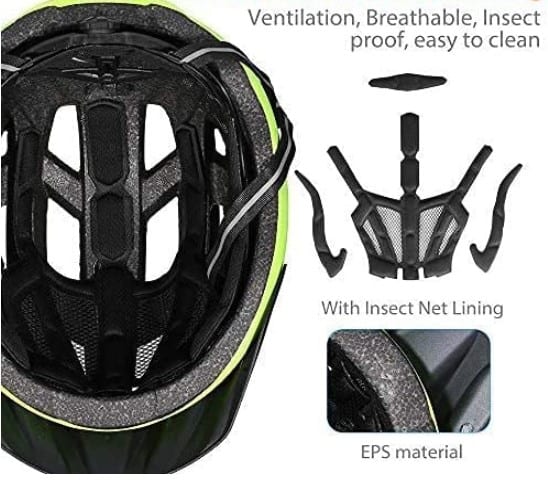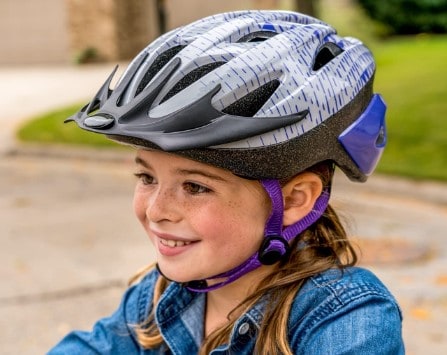A cycling helmet is an essential gear for a cyclist as it offers head protection. But, what is the essence of wearing a helmet whose effectiveness is no longer assured? I’m talking about an expired helmet. But do bike helmets expire?
Ordinarily, a good helmet should last you 5 years with proper usage and good maintenance. However, if you don’t take care of it, the lifespan shortens.
Actually, organizations like the Consumer Product Safety Commission (CPSC) and the Snell Memorial Foundation (SMF) recommend replacing your helmet after five years.
Nonetheless, you don’t have to wait for five years to replace your cycling helmet. It would help if you did it immediately after a crash, when you notice signs of wear, and when the helmet is no longer safe.

Do Bike Helmets Expire? Signs of an Expired Helmet
Findings by the Consumer Product Safety Commission (CPSC) and the Snell Memorial Foundation (SMF) clearly show that helmets have an expiry, which is five years.
Why 5 Years?
SMF argues that most helmet materials naturally start to degrade as soon as you start using the helmet, and the degradation is at its peak after five years.
They also argue that a helmet comes into contact with hair oils, body fluids, and sunblock, which ruin it slowly, and the ruin gets worse with age.
Finally, safety standards and design change constantly, and so a lot could have changed in five years. To play it safe, you should get the latest design that complies with the latest safety standards.
Must It Be 5 Years?
Yes, we’ve talked about five years been the age of replacing bike helmets. But does that mean that you have to wait for five years to replace your helmet?
Of course not, especially when you notice any of the signs below.
1. A Recent Crash
A helmet’s primary goal is to protect your head during a crash. So, if you crash while wearing it, it becomes less effective, which means you’ve to replace it to receive optimal protection.
Generally, cycling helmets feature EPS (expandable polystyrene) foam lining that absorbs the impact of a crash.
The lining is only suitable for a single hit, and once it happens, its effectiveness reduces because it cannot regain its original compressed structure.
2. Exterior Wear
You’ve to keep an eye on the helmet shell as it is your first line of protection. Also, it maintains the foam’s structural integrity, which cushions your head against shock.
Look for cracks, splits, and tears on the shell. If you notice any even before a crash or the 5-year expiry period, replace your cycling helmet right away.
Also, watch out for bumps on the helmet shell, and if the shell’s color is fading, replace it.
3. Interior Wear
There are several signs to indicate a worn-out helmet interior. For starters, look at the foam liner to see if it’s split or dented.
If the parts move about, that also shows that the helmet needs replacing. Also, watch out for frayed or torn straps and broken buckles.
If you notice anything odd, replace the helmet right away.

4. Missing Pieces
If something is missing from the helmet, it could impact its effectiveness, no matter how small. So, you have to examine the exterior and interior to ensure that nothing is missing.
5. Bad Fit
If the helmet no longer fits, then you have a valid reason to replace it. You wouldn’t want to wear a too loose helmet as it could slip off your head when cycling fast.
Similarly, you wouldn’t want to wear a tight helmet as it could compress your head.
So, if you don’t like your helmet because of its fit, get a fitter one. A Schwinn bicycle helmet like the Schwinn Thrasher Bike Helmet is a fantastic choice for kids and adults.
Are There Other Reasons for Replacing Your Bike Helmet?
Also, replace your helmet if:
- It’s a 70 Edition
Helmets from the 70s lack Styrofoam liner, which is so common nowadays. Styrofoam liner is an upgrade of the old foam liner, and so it offers more head protection.
So, if your helmet is a 70 edition, drop it and get the newest design.
- It Lacks Safety Standard Stickers
You can tell a safe helmet by looking at its safety certification stickers. If the stickers are present, especially CPSC, Snell, or ASTM stickers, the helmet meets today’s safety standards.
If none of the stickers is present, then the helmet is not safe.
- You Are No Longer Comfortable Wearing It
Your cycling helmet should inspire confidence when wearing it. If you no longer feel confident or feel like the helmet is out of style, replace it.

FAQs (About Do Bike Helmets Expire)
1. Do Bicycle Helmets Expire?
Yes, helmets do expire. Usually, you should replace your helmet after five years. You should, however, do it sooner after a crash and when you detect signs of wear and tear.
2. How Long Do Bike Helmets Last?
Typically, helmets are expected to last five years with proper care, maintenance, and usage. You can, however, expect the time to shorten with frequent use and lack of appropriate care.
3. But How Often Should You Replace Your Bike Helmet?
Generally, you should replace your cycling helmet after five years. That’s because the helmet naturally reaches its wear peak after five years.
But still, some situations call for the immediate replacement of a bike helmet.
Here’s when to replace bike helmet:
- A recent crash
- Signs of outside or interior wear
- If the helmet no longer fits
- If the helmet lacks safety stickers
- An older design
4. What Shortens The Lifespan Of Cycling Helmets?
Here are things known to reduce a helmet’s lifespan:
- Impact
While most people associate the term impact with a crash, there is more to the word. Remember, your helmet hits things in the course of its lifetime.
You also sometimes drop it or rub it against other cycling gears. All those are sources of impact and can wear down your cycling helmet.
- Sun Degradation
UV light from the sun is naturally intense, and so the more you ride in the sun while wearing a helmet, the brittle its shell becomes.
Remember, the shell keeps the foam lining in its place and so if it’s brittle, then the foam integrity becomes compromised.
- Chemical Attack
Pesticides, rodenticides, and other chemicals containing DEET are too potent for helmet construction. They erode the surface, weakening the helmet shell.
So, if you spray your helmet with a DEET chemical, its effectiveness will reduce faster. What’s more, the chemical may fade the helmet shell.
- Lack of Care
Sweat, sunblock, and hair oils can shorten the life of a helmet. That’s why it’s advisable to clean a helmet as often as possible, especially after cycling.
5. What Determines the Lifespan Of Cycling Helmets?
Here are several things that dictate how long a helmet will last you:
- Frequency of usage – You don’t expect your helmet to last you longer if you wear it regularly. The more often you use it, the likelier it is to wear.
- General handling – Rough handling of the helmet can reduce its lifespan. That includes frequent dropping of the helmet and knocking it often.
- Care and Maintenance – Proper care and maintenance of a helmet improves its lifespan. Some people claim to use helmets for more than five years because of proper care.
- Helmet storage – You have to store your helmet correctly when not in use. If you keep it in a place where it’s exposed to the sun, the shell will become brittle. You also have to avoid areas prone to pests/rodents as they can attack the helmet.
6. What Should You Do With An Old Bike Helmet?
Old helmets undoubtedly are unique collectibles for someone who likes collecting vintage stuff. However, as far as your cycling safety is concerned, you shouldn’t wear an old helmet as its effectiveness is no longer assured.
What you should do instead is keeping it as part of your vintage collection. Alternatively, you can reuse some parts after taking the bike helmet apart.
For example, you can use the outer shell as a recycling bin and the EPS foam as a soil softener or packing material.
You can also use the helmet to plant flowers, vegetables, or herbs.
7. Which Is The Safest Bike Helmet?
Overall, there are different cycling helmets for different groups of cyclists.
Below is a summary of what to get depending on your preference. Mark you; all these helmets meet the necessary safety standards and are therefore safe.
- Schwinn Infant Bike Helmet: Best for Infants
- Bell Marvel Spiderman Hero Helmet: Best for 5-8-Year Olds
- Bell Thalia Women’s Bike Helmet: Best for Women
- Giro Tremor MIPS Cycling Helmet: Best for Youths
- Schwinn Thrasher Bike Helmet: Best for All Ages
Relevant Post:
Closing Thought
So, do bike helmets expire? According to studies, there is no doubt that helmets expire over time, which is about five years. So, once your helmet reaches its expiry, replace it to stay safe on the road.